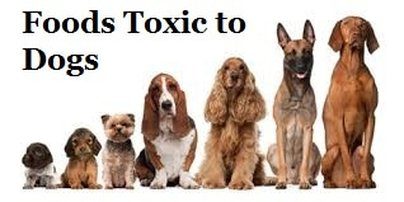
It’s Saturday morning, and for some strange reason, your dog lets you sleep in. Not that you miss that 5:30 a.m. wake up nudge, but it’s unusual for him to sleep through that first trip to the outdoor bathroom. Then you hear him in the other room; he’s pacing and panting, and he’s had diarrhea. You look in the kitchen and see the torn wrappers of two chocolate bars. You know chocolate is one of the foods that is toxic to dogs, so you grab your keys and head to the emergency vet.
Anyone who owns a dog is probably familiar with a situation similar to this. There’s no way around the fact that dogs get into things they aren’t supposed to. Most of the time it’s harmless, even if it is annoying and occasionally smelly. But there are some pretty surprising foods that are toxic to dogs that could send your pet to the animal hospital, or worse, if they don’t get treatment quickly enough.
1. Chocolate
Dogs love chocolate, but no matter how much they look at you with those puppy dog eyes, keep the chocolate away. Chocolate contains both caffeine and theobromine—two substances that dogs are especially sensitive to. According to petMD, the symptoms of chocolate ingestion may include vomiting, diarrhea, rapid breathing, seizures, and even heart failure or coma.
2. Caffeine
Caffeine comes in chocolate, and, of course, coffee, but did you know there is also caffeine in green tea, protein bars, and some sodas like Mountain Dew and Barq’s Root Beer? The Pet Poison Helpline notes that eating tea bags or as little as a one or two diet pills “can easily cause death in small dogs or cats.” Symptoms of caffeine ingestion include a high body temperature, hyperactivity, tremors, or vomiting.
3. Grapes and raisins
Grapes, raisins, and currants are all potentially poisonous to dogs. That includes snack bars, trail mix, and cereals with raisins in them. Individual dogs may react differently, but unfortunately, the most visible signs of poisoning don’t appear until your dog is in the beginning stages of acute kidney failure. Ahna Brutlag, DVM at VCA Animal Hospitals, writes that immediate and aggressive treatment is your dog’s best chance at survival. Symptoms are non-specific but include vomiting and excessive urination, as well as abdominal pain.
4. Onions and garlic
Onions and garlic are two of the most surprising foods that are toxic to dogs. In fact, small amounts may not cause a problem. However, large quantities—or small quantities eaten regularly—can cause severe anemia. Dr. Scoot Nimmo, MRCVS, BVMS, writes on vetblog.net that the initial symptoms of onion toxicity are drooling, vomiting, or lethargy. You should also look for blood in your dog’s urine, an elevated heart rate, and pale gums over the next several days if you think your dog has eaten onions or garlic.
5. Macadamia nuts
Your dog may love peanut butter, but keep her away from macadamia nuts. VetWest Animal Hospital warns that eating macadamia nuts may lead to vomiting, weakness, fever, and muscle tremors. Fortunately, the prognosis is good as long as your dog receives supportive medical attention.
6. Dough
It may be tough to believe that bread dough is toxic to dogs, but it’s true. In fact, unbaked bread dough could be deadly. As the dough rises and expands in your dog’s stomach, it can lead to bloat and a twisted stomach. Symptoms of bloat include a distended stomach, retching, weakness, an elevated heart rate, and death. If treated quickly and aggressively, your dog could recover, but the prognosis is not good in severe cases.
7. Xylitol
You may not recognize xylitol, but it is almost certainly in your cupboard. Xylitol is a sweetener in everything from toothpaste to gum to candy. The ASPCA points out that it can cause an “increase in insulin leading to hypoglycemia (lowered sugar levels).” Symptoms may include vomiting, lethargy, and seizures.
8. SalmonWho would have guessed that salmon is among the foods toxic to dogs? According to petmd.com, if your dog eats raw salmon infected with the Neorickettsia helminthoeca parasite, he may end up with systemic hemorrhaging. Symptoms include vomiting, diarrhea, and discharge from the eyes and nose. The positive news is that the prognosis is good for pets treated promptly.
9. Popcorn
Ok, who among us hasn’t used popcorn as a treat for our dogs? Yes, your dog probably loves popcorn, and plain popcorn certainly isn’t the worst thing your dog can eat. But unless you pop your own popcorn at home, chances are that treat is loaded with sodium.
The Pet Poison Helpline says that salt poisoning can lead to fluid retention, vomiting, excessive thirst, excessive urination, tremors, seizures, and coma.
What to do if your dog is poisoned:
- If you suspect or know that your dog has eaten one of these foods, call your veterinarian. Quick treatment is paramount for a good outcome, so they will probably want to see your dog right away.
- If your dog is having seizures, move him to a safe space away from stairs or furniture and get to the vet as soon as possible.
- If you can’t reach your vet or an emergency animal hospital, call the Pet Poison Helpline. Do not induce vomiting without consulting a veterinary professional.
We hope you and your dog never experience any of these frightening events, but it’s good to prepare for the unexpected.
EMERGE INSURANCE AGENCY
904-677-5884


